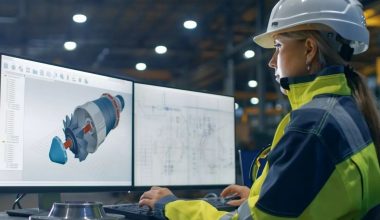Aerospace engineers are responsible for some of the most incredible feats of mankind. From manufacturing aircraft and spacecraft to producing the equipment that makes weather forecasts, mobile phones, television broadcasts, and space flight probable.
In fact, Aerospace engineering is an always evolving field and one of the most challenging career paths in the world. However, regardless of the challenges, there are several career options and jobs you can pursue with a degree in aerospace engineering.
Basically, an engineering career that’s absolutely appealing to those who are interested in making aircraft and spacecraft is aerospace engineering.
Not only does it allow you to dabble on all things that fly on a daily basis, but it’s also a very lucrative profession that potentially gives a mean annual wage in the six figures for those with experience.
So, the first step to take before choosing to become an aerospace engineer or getting a job here is to determine if this career is well suited to your personal traits, your skills, your professional ambitions, and your desired lifestyle.
To be more precise, many in this profession also have a natural aptitude in math, science, and technology. They are majorly individuals with creativity and determination; individuals who are able to work patiently and diligently towards their goals, and they typically don’t get discouraged easily.
So, this article will give you the necessary information you need to know as regards to pursuing a career here. The marketable careers here, their qualifications, and the salaries of these various job options in the aerospace engineering field.
Here is a table of what to expect:
Table of contents
What is Aerospace Engineering?
Aerospace engineering is an engineering field that covers the development of aircraft and spacecraft. It is one of the fastest-growing, dynamic disciplines that focuses on the design, maintenance, and improvement of all types of aircraft, from airplanes to missiles and space shuttles. (7ziphelp.com)
There are two major and overlapping branches in the aerospace engineering field: aeronautical engineering and astronautical engineering.
We’ll look at each of them as we go further into the marketable careers and jobs in aerospace engineering.
Before then, similar to Aerospace engineering is the Avionics engineering which deals with the electronics side of aerospace engineering.
Now, let’s to know the Aerospace Engineer and what he/she does.
Who is an Aerospace Engineer?
An aerospace engineer is one who designs primarily aircraft, spacecraft, satellites, and missiles. Basically, aerospace engineers evaluate designs to see that the products meet engineering principles.
Aerospace engineers may also develop new technologies for use in aviation, defense systems, and spacecraft.
Basically, they often specialize in areas such as aerodynamic fluid flow; structural design; guidance, navigation, and control; instrumentation and communication; robotics; and propulsion and combustion.
To become an aerospace engineer, you need to be interested in the field as well as develop necessary skills. Then, pursue a 4 to 5 years bachelor degree program in aerospace engineering or a related field.
What Does an Aerospace Engineer Do?
Here are the major duties of an aerospace engineer:
- Directing and coordinating the design, manufacture, and testing of aircraft and aerospace products.
- Assessing proposals for projects to determine if they are technically and financially feasible.
- Determining if proposed projects will result in safe operations that meet the defined goals.
- Evaluate designs to ensure the products meet engineering principles, customer requirements, and environmental regulations.
- Developing acceptance criteria for design methods, quality standards, sustainment after delivery, and completion dates.
- Ensuring that projects meet quality standards.
- Inspecting malfunctioning or damaged products to identify sources of problems and possible solutions.
Get a degree in aerospace engineering, see the Best Aerospace Engineering Schools in the World
Where Does an Aerospace Engineer Work?
Aerospace engineers majorly work in industries where they design or build aircraft, missiles, systems for national defense, or spacecraft.
They are employed primarily in manufacturing, analysis and design, research and development, and the federal government.
Typically, employers of aerospace engineers include:
- Aerospace and aero-engine companies
- Airline operators
- Research and development organizations
- Contract agencies
- Government agencies like The Ministry of Defence
- Consultancies
- The Civil Service
- The armed forces
- Universities
How Much Does an Aerospace Engineer Earn?
According to the US Bureau of Labor Statistics, the median annual wage for aerospace engineers is $116,500. That is to say, aerospace engineers earn $56.01 per hour.
Meanwhile, the Alberta Wage and Salary Survey reports that Albertans working in the Aerospace Engineers occupational group earn an average salary of $106,900 per year in Canada, and those working in the Mechanical Engineers group earn an average of $94,843 per year.
What is the Job Outlook of Aerospace Engineer?
Still from the report of the US BLS, the employment of aerospace engineers is expected to increase by 2 percent from 2018 to 2028.
For this reason, a projected decline in the employment of aerospace engineers in the manufacturing industry will temper growth in research and development activities.
What are the Marketable Careers in Aerospace Engineering?
The aerospace engineering field is vast and with a degree in it, there are so jobs and career options for you.
Here are some marketable and profitable careers you can pursue in the aerospace engineering field:
- Aerodynamic Engineering
- Aeronautical Engineering
- Astronautical Engineering
- Aircraft Design Engineering
- Aircraft Designers
- Flight Test Engineering
- Aircraft Engineering
- Aircraft Performance Engineering
- Rocket Engineering
- Wind Tunnel Engineering
#1 Aerodynamic Engineering
A career in Aerodynamic is definitely a profitable and marketable one in the aerospace engineering field.
Basically, aerodynamics is the study of the effect of gas flows, such as air, around a body, and the forces and moments generated. The general understanding of aerodynamic in aerospace engineering is vital for the design of efficient, capable, and competitive aircraft, and aerodynamics has an important role in making aircraft more environmentally friendly.
How Can I Become an Aerodynamic Engineer?
To pursue a career in aerodynamics engineering, you will need at least a bachelor’s degree in aerospace or mechanical engineering. However, some employers may require you to have a master’s degree, or higher, in one of these areas for you to become an aerodynamics engineer.
Besides the education qualification, some employers may require candidates for aerodynamics engineer jobs to have experience with certain software or simulation programs.
What is The Salary of an Aerodynamic Engineer?
As seen on Glassdoor, the national average salary for an Aerodynamic Engineer is $79,714 in the United States.
#2 Aeronautical Engineering
Aeronautical engineering is one of the two major branches in the aerospace engineering field and one to consider if you intend getting a job in the field.
Basically, aeronautics engineering is the science or art which covers the study, design, and manufacturing of air flight-capable machines. It also includes the techniques of operating aircraft and rockets within the atmosphere.
It represents the branch of engineering that deals with the research, design, development, construction, testing, science, and technology of aircraft. The aeronautical engineering field also covers the investigation into aerodynamic characteristics of aircraft, including behaviors and related factors such as airfoil, control surfaces, lift, and drag.
How Can I Become an Aeronautical Engineer?
To pursue a career as an aeronautical engineer, you must have a bachelor’s degree in engineering (civil, electrical, electronic, chemical, industrial, mechanical, aeronautical, or computer) or in a technical field.
Also, you must have significant work experience in a relevant field. For example, having experience with aeroacoustics, aerodynamics, or computational fluid dynamics is preferred.
It is important to note that a master’s degree in aeroacoustics or a related is also often preferred by employers here.
What is The Salary of an Aeronautical Engineer?
As seen on Glassdoor, the national average salary for an Aeronautical Engineer is $80,000 in the United States.
However, on payscale, the average salary an aeronautical engineer earns is $78,442 per year.
#3 Astronautical Engineering
Astronautical Engineering is the second major branch of aerospace engineering. Basically, astronautical engineering deals primarily with aircraft that function outside the atmosphere of Earth.
Astronautical engineers are specialized aerospace engineers that design, developing, and testing aircraft and equipment that operate outside of the earth’s atmosphere.
How to Become an Astronautical Engineer?
To become an astronautical engineer, you’ll need a degree in aeronautical or aerospace engineering or a degree in mechanical engineering with a focus on aerospace engineering. Also, a bachelor’s degree in applied science can qualify you to work in entry-level positions within the field.
What is The Salary of an Astronautical Engineer?
Just like the Aeronautical Engineer, the national average salary for an Astronautical Engineer is $80,000 in the United States.
Get to know more about the astronautical engineer. Read Study Astronautical Engineering: Best Schools, Careers, and Salaries
#4 Aircraft Design Engineering
A job as an aircraft design engineer falls under the broader career category of Aerospace Engineers.
Basically, aircraft engineers design and test aircraft and aerospace-related equipment. They also make sure that aircraft are well maintained and that all safety procedures are followed.
Aircraft design engineers are to create blueprints and schematics for aircraft and aerospace-related systems, machines, and equipment. They usually work with a team that includes several members, including aerospace and mechanical engineers.
Generally, they follow plans and models to create aircraft and aerospace-related equipment, products, or models. Sometimes, aircraft design engineers will be given direct orders and will be asked to construct prototypes to test in certain situations.
How to Become an Aircraft Design Engineer?
To become an aircraft design engineer, you must have a bachelor’s degree in aerospace engineering or another field of engineering or science related to aerospace systems. Degrees in civil, mechanical, or electrical engineering are accepted.
Also, aircraft design engineers must have advanced computer and application knowledge.
However, if you want to advance in the career, then you will need to earn a master’s or doctoral degree in aerospace engineering or a related field, and also consider opting for professional certification.
What is The Salary of an Aircraft Design Engineer?
Just like other design engineers, the aircraft design engineer earns an average salary of $67,934. This is as seen on Payscale.
#5 Aircraft Design
Aircraft design is one of the sought after careers you can pursue in the Aerospace Engineering field.
According to Wikipedia, the aircraft design process is a loosely defined method used to balance many competing and demanding requirements to produce an aircraft that is strong, lightweight, economical, and can carry an adequate payload while being sufficiently reliable to safely fly for the design life of the aircraft.
Aircraft designers who know and understand aerospace engineering are needed to help countries and companies get their dreams of space travel jet (literally) off the ground. Because of the tremendous risks involved, most aircraft designers spend most of their time working on supercomputer simulations.
How to Become an Aircraft Designers?
Most jobs for an aircraft designer require a bachelor’s degree within a broad range of engineering or science fields in addition to aeronautics or astronautics, such as mechanical, electrical, structural, materials, and even civil engineering.
Other jobs for people who want to pursue a career in this aerospace engineering field might require training in systems safety, human factors, air-vehicle integration, or aesthetic design.
Also note that most people entering the field are expected to have CAD/CAM and CNC training and capabilities.
What is The Salary of an Aircraft Designers?
According to Glassdoor, the national average salary for a Aircraft Designer is $58,013 in United States.
#6 Flight Test Engineering(FTE)
Flight test engineering is a very important aspect in aerospace engineering and as such pursuing a career here will be profitable to you.
According to Wikipedia, a flight test engineer is an engineer involved in the flight testing of prototype aircraft or aircraft systems.
Generally, the flight test engineer generally has overall responsibility for the planning of a specific flight test phase, which includes:
- preparing the test plans in conjunction with other analytical and/or systems engineers, overseeing the buildup of the aircraft to the proper configuration,
- working with the flight test instrumentation engineer to ensure the sensors and recording systems are installed for required data parameters, and
- preparing the maneuver-by-maneuver plan for each test flight (enshrined typically in a higher-level document called a “test plan” and then an operational document usually called the “test cards”).
In fact, the FTE and the experimental test pilot are jointly responsible for the safety of the test flying.
How to Become a Flight Test Engineer?
To become a flight test engineer, you will need a degree in aerospace, mechanical or, electrical engineering, or cognitive science. Although a bachelor’s degree is generally required, and a master’s degree is recommended.
Also, note that many university aerospace engineering departments offer elective flight test courses for those interested in this field of engineering.
What is The Salary of a Flight Test Engineer?
Payscale reports that the average salary for a Flight Test Engineer is $86,903. Meanwhile, the national average salary for a Flight Test Engineer is $71,478 in the United States.
#7 Aircraft Engineering
An aircraft engineer ensures that airplanes within a fleet of air services providers are properly maintained, repaired, and safe for flight.
Basically, the engineer performs a variety of daily inspections on different aircraft, logs the results of any anomalies or tests performed on the airplanes, and performs or oversees any necessary repairs and re-inspections.
In schools, aircraft engineering focuses on a mixture of mathematics and science-based courses. Students cover a range of topics, like aerospace engineering mechanics, aerospace dynamics, theoretical aerodynamics, and structural analysis.
How to Become an Aircraft Engineer?
Employers will likely want you to have a bachelor’s degree in engineering, a related curriculum, or equivalent combination of education and experience sufficient to successfully perform the essential functions of the job.
Some employers will want you to have a graduate degree in aerospace, electrical or mechanical engineering, depending on the complexity of the tasks you will be performing, and your level of responsibility within the aircraft performance team.
What is The Salary of an Aircraft Engineer?
An aircraft engineer in the USA earns an average salary of $69,000 per year.
#8 Aircraft Performance Engineering
As far as the performance of an aircraft is necessary, then, the aircraft performance engineering will also be an important aspect in the aerospace engineering field.
Basically, as an aircraft performance engineer, you would apply advanced engineering principles to the design and development of aircraft, to ensure that they operate at optimal levels, safely and efficiently.
How to Become an Aircraft Performance Engineer?
To become an aircraft performance engineer, you will need a bachelor’s degree in engineering, a related curriculum, or equivalent combination of education and experience sufficient to successfully perform the essential functions of the job.
However, some employers may want you to have a graduate degree in aerospace, electrical or mechanical engineering, depending on the complexity of the tasks or job you will be performing, and your level of responsibility within the aircraft performance team.
What is The Salary of an Aircraft Performance Engineer?
An aircraft performance engineer in the USA earns an average salary of $84,803 per year. This is as seen on payscale.
#9 Rocket Engineering
Rocket engineering, sometimes called rocket science is an important aspect of aerospace or astronautical engineering. Generally, it deals with the design and manufacture of spacecraft.
Rocket engineers are aerospace engineers who specialize in the design and manufacture of spacecraft. They basically work with the principles of science and engineering to create vehicles that fly within or above the Earth’s atmosphere.
How to Become a Rocket Engineer?
To pursue a career as a rocket engineer or scientist, you will need a bachelor’s degree in aerospace engineering as the minimum requirement.
Also, the job of a rocket scientist in areospace engineering requires proficiency with physics, chemistry, aerodynamics, propulsion, communications, and mathematics.
What is The Salary of a Rocket Engineer?
The national average salary for a Rocket Engineer is $72,323 in the USA. This is as seen on Glassdoor.
#10 Wind Tunnel Engineering
Basically, wind engineering is a subset of mechanical engineering, structural engineering, meteorology, and applied physics that analyzes the effects of wind in the natural and the built environment and studies the possible damage, inconvenience, or benefits that may result from the wind. In the field of engineering, it includes strong winds, which may cause discomfort, as well as extreme winds, such as in a tornado, hurricane, or heavy storm, which may cause widespread destruction.
In wind engineering, wind tunnel tests are used to measure the velocity around, and forces or pressures upon structures
On the other hand, wind tunnels are large tubes with air blowing through them. These tunnels are used to replicate the actions of an object flying through the air or moving along the ground.
In fact, researchers use wind tunnels to learn more about how an aircraft will fly. Also, NASA uses wind tunnels to test scale models of aircraft and spacecraft.
In the definitions above, you will see that wind tunnel engineering will always be a very important aspect of aerospace engineering as long as aircraft and spacecraft exist. And as such pursuing a career as a wind tunnel engineer is definitely going to profit you in the aerospace engineering field.
How to Become a Wind Tunnel Engineer?
To become a wind tunnel engineer, you’ll need a bachelor’s degree in mechanical engineering, meteorology, applied physics, or related engineering field (like aerospace, or structural engineering, etc).
What is The Salary of a Wind Tunnel Engineer?
According to ZipRecruiter, the average annual pay for a Tunnel Engineer in the United States is $105,497 a year.
Meanwhile, Comparably reports that the average Wind Tunnel Engineer in the US makes $97,571.
Conclusion
With a median annual wage of $116,500, a career in the aerospace engineering field is definitely a profitable one.
In fact, with a degree in aerospace engineering or a related field, you’ll surely find several jobs in this field.
Do well to go through their qualification and salaries above to know the one that best suits your individual and career goals.
I hope this article on marketable aerospace engineering careers helps you in your decision making.
Good Luck And Success!!!
References
- US BLS – Occupational Outlook Handbook of Aerospace Engineers
- RaiseMe – Aerospace Engineers: Salary, career path, job outlook, education and more
- Zippia – Working As An Aerodynamics Engineer
- CareerExplorer – What does an aerospace engineer do?
- AcademicInvest – Careers with a Mechanical Engineering Degree
- Quora – How do I become an aircraft design engineer?





